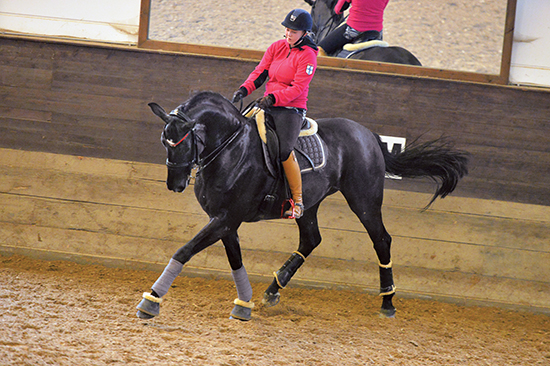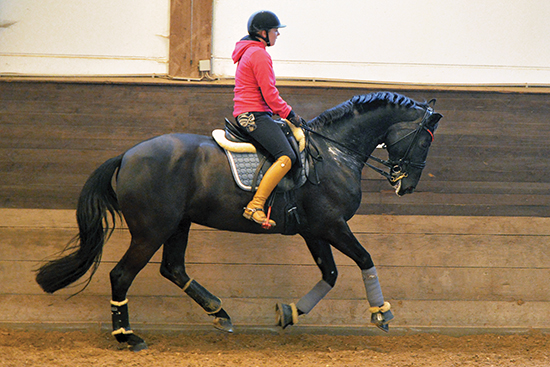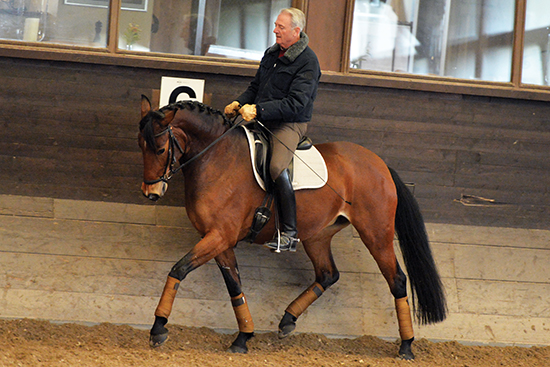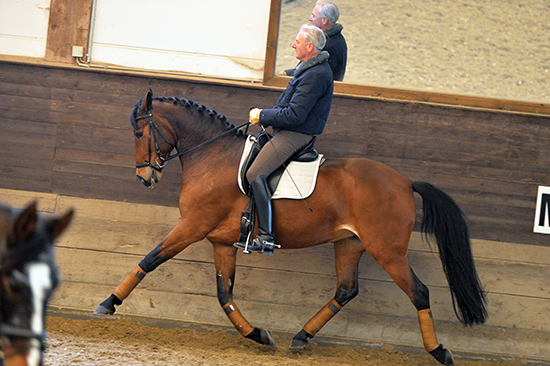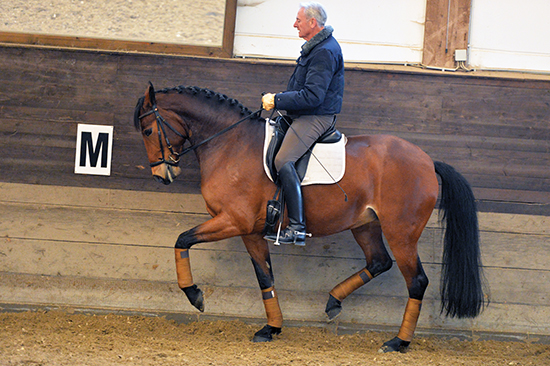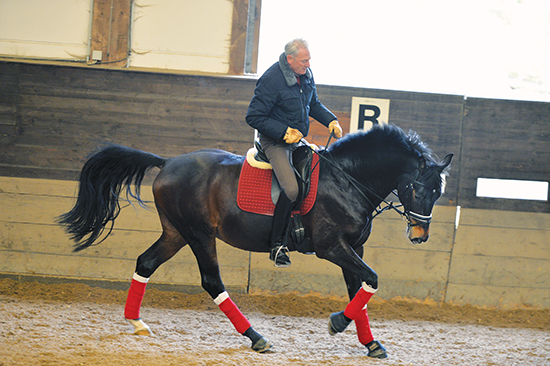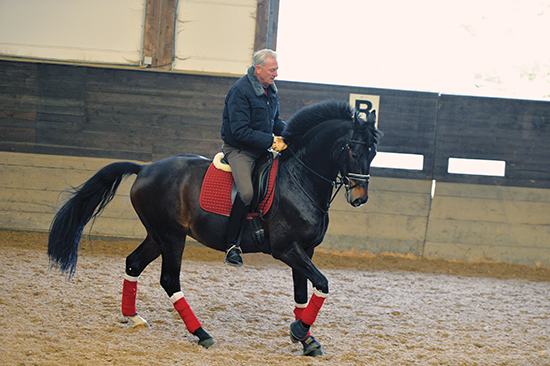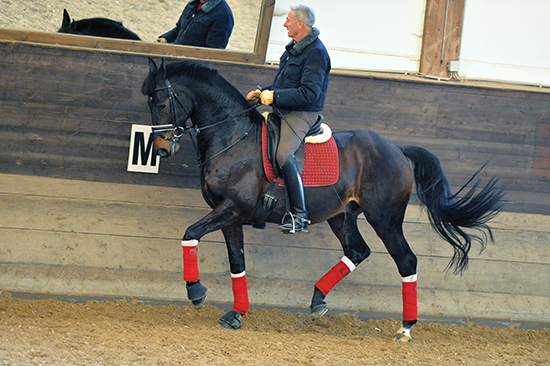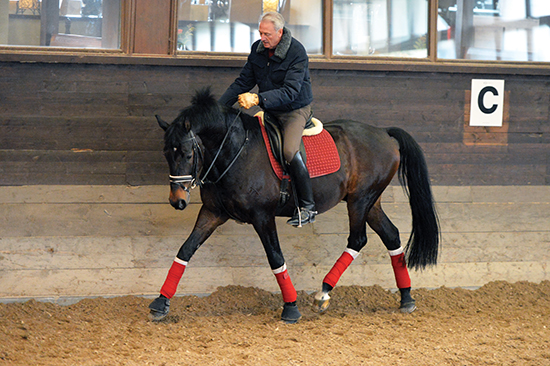Story by Christopher Hector & Photos by Roz Neave
It is always a special privilege to watch Jean Bemelmans teach and ride, even if this time it did mean freezing in the arctic temperature of the riding hall at Ratingen just outside Dusseldorf.
Certainly it is a learning experience to see how Jean deals with the challenges that his pupils occasionally present him. In this case it was a determined, but not greatly talented rider on a couple of very nice horses, or really one okay horse and one superstar stunner. The young rider rode one horse really short and tight, and the other long and loose, I remarked to Jean that ‘usually if a rider has one problem, often they have the same problem with all their horses, but she had one horse too short and tight, and the other too long and loose…’
“First of all the horse tells you the way of working, so the first horse has a short neck and a long body, the second horse has a very long neck and quite a short body. If the first horse shortens his neck, then he cannot use his body, he needs to lengthen his neck to use all the muscles of his body.”
“The black one, has this long neck, so if it goes up, then the short back is not swinging, so you have to go a bit low and deep, and a little bit more relaxation. Everything has to do with conformation, how the neck is formed, where the neck is, which position it is. Is the back short or long? How do the hindquarters work – because you can have a perfect back, a perfect neck and a lazy hindquarter.”
“The mare with the long neck, she is a super talent, I think she is one of the best horses in the world, the problem is that the people who own her don’t listen to my system. They bought the mare at the PSI auction a few years ago, I think it was like 600,000 euros, the horse came here, we were riding the horse, and she went to her first competition as a five-year-old and won immediately. Then she had a little injury because she was out in the field and trod on a nail. So the horse went out for a while, then they didn’t bring it back. We will try ourselves…”
“You see today that the basic is not really done, she is a beautiful horse, a wonderful mover, I think she is one of the best horses I have ever had in my life, but she is not under control. It is a shame, I was talking with the people today, and I said, look your daughter comes once a month, or every two months, how can we improve? I said, give me the horse for a month or maybe two, just so I can get it a little bit in order.”
“The difficult moment is always to pass from five to six, the first flying change is always a big step. There are many steps: the first step is breaking in, so the horse has to be broken in in a nice way and you have to keep the horse calm. Then five, and then you have to start something, and the first flying change – and if you don’t do that well, the horses learn to escape. This is what has happened with the mare, that the rider doesn’t really have good control over the horse.”
If you were given the black mare to ride tomorrow, what would your program look like?
“Basic work, coming going, coming going, because this is what she cannot do. She is doing flying changes, but the horse is doing them on her own, not in control – so you have to do small canter, big canter, control the body, control the movement, have the horse in confidence and obedience again because the horse is now in a constant discussion with the rider. The discussion has to go, she has to have confidence, if I say go, she has to go, if I say come back, she has to come back. I have to go a little bit sideways, left and right and when this is okay, then I go back to the changes.”
There was one horse that was thoroughly on program, and that is Jean’s little Lusitano / Warmblood cross. When he started riding the mare, you thought, what is this funny little creature. But sit, watch, concentrate… and learn.
“This is a lovely horse that we bought last year. I ride her myself more or less every day, we bought her when she was five, now she is six. Last year we took her to Barcelona, where she won an M class, then we left it because she has to grow but she has a super talent, she picks up already a little piaffe / passage.”
“I can do two tempi, I could start one tempi if I like. She is positive. I had her right from the beginning, so whatever you ask, she does it. She doesn’t know there is a way out. She is out of a Lusitano mare by Fürst Romancier, Sylvain Massa, of the Elevage Massa, bred her.”
Is that a way forward for the Iberian horses, to breed with German Warmbloods…
“I think it is the way forward. I like the Lusitano horses because they have a lot of talent, they are very willing horses and if you can give them a little more quality in the gaits, why should it not work?”
It seems to work better with the Lusitanos than the Andalusians…
“Yeah because the Lusitano is more a sport horse than the Andalusian. They are a bit longer in the back. The Andalusians are quite short, and short in movement and very uphill. The Lusitanos are breeding a little more in the direction of dressage.”
TIME OUT TO TALK
You say the riders need a system – is your own system very different from when you started out?
“I was five years in one of the best places for someone at that age to be, and I am very thankful to Mr Robert Schmidtke who was my teacher. He taught me everything and I still work in this way. Of course it changes a little, you develop in self confidence, the horses teach you, but the system remains the same.”
“In Germany if you sit on a horse and want him to go forward, you take him with your leg and you let him go forwards, and when you want him to come back, you sit and you bring him back on the leg. This is the system. Some people say, no we have a different system, if we want him to go forward, we push but when we want him to come back, we stop him in front, but we don’t use our leg. Okay, if you have success, then at the end of the day, no one will ask you how you get success, but I have a system, and I believe I this system, and I keep to that system.”
“Later you adapt that system on the demands of your horse, because every horse is different, but I think the German way of riding, the basic, is a very good basic. Many countries profit from German trainers – Klaus Balkenhol went everywhere in the world, and he gave his system, but this is the German system. Jürgen Koschel, Wolfram Wittig… there are so many, but they all learnt the same system. Okay, it is not 100% the same because everybody adapts, one is more strong, one is less strong, but the basis of the German system is very strong.”
“That’s what makes Germany very strong. Good professionals. They study at Warendorf, they are well-educated. In many countries, there are rich people who can come to Germany and buy expensive horses but when they take them home there is no one there to help them. The basics of the trainers is the most important thing. I did the clinics at Warendorf for twenty years, I worked for the German Federation for twenty years, after Harry Boldt, I did all the clinics at Warendorf, we had all the professionals, maybe they were not big names, Hubertus Schmidt, he came to the clinics – now he makes the top horses. Wolfram Wittig was there. It’s not that I made Wolfram Wittig, but he came, and the professionals are the basis of the country. Top stars come and go with their horses, but the professionals are always there, and they keep producing.”
“This is what I see in France, we have quite good riders, good horses, but we don’t have the bereiter / professionals.”
These photos are of Jean riding a Painted Black gelding…
Is it a little in France like it is in Australia, that it is very hard for the riders, especially the young riders, because they are not seeing top riders and trainers in action every day, here in Germany, if you are in a yard with someone like Wolfram Wittig, you are seeing good riding the whole of the time, you go to the show and go in the warmup arena and you are seeing good riding all the time, and in the competition it is the same. But in our country, most of the time, the riders work by themselves, when you go to the show, maybe one or two good riders, most not so good, one or two tests, the rest are not so good, it makes it very hard for our developing riders – which is why many of them have to travel to Europe to get to the top…
“If a country wants to be successful, then they have to build up a system that makes good professionals. This is four, or five steps back but for long term thinking, this is the best way. Fifteen years I was in Spain, and we won seven medals in that time, but the best thing I did in Spain was to leave the country with good professionals – Rafael Soto, Ignacio Ramblas, Daniel Martin – I was just in Florida, helping Daniel, and I am going back next week to help again. He just won the Special in Florida, these guys, they are good, they will produce.”
“Now this is what I would like to do in France. We had a discussion in the French Federation, how to do it. I said we have to make clinics OPEN – for everybody. Maybe someone comes around the corner, and we help him on his way. This was always my plan – when I did the clinics in Germany, I said, don’t look at the top stars, you don’t need to help them, you need to help the beginners, you need to teach them what dressage is, this is the hardest part. And that is what we do now, we make clinics, and okay some people will never make it and so we kick them out, but have a lot of riders. At the last clinic we had over 40 horses, and we said, okay we take them all, and we make three clinics. Work is always good. Then they start to understand that dressage is a long way, but out of these clinics, will come top stars some day. Nicole Uphoff, Isabell Werth, they all started to ride in a club…”
But it is interesting, you see riders who work hard, they are intelligent, they know the theory, they go to good trainers, they have nice horses, but it doesn’t work – but other people, they just have it, it is a cruel sport, being good, intelligent, hard working, is not enough, there is some extra magic in the mix…
“I give you an example. One day I was talking with a man, and he educates falcons for hunting. He said, you have falcons that are born in the wild, and the other ones are bred in captivity, and the one you catch in liberty is always the better one, because he has it. The other thing is that there is a lot of luck in every sport, this is something you cannot buy, but it is a good thing…”
When you started working with your Spanish riders, how soon could you see that for example, Rafael had it…
“At the end of the day you know it better than at the beginning of the day, otherwise I would be a magician. A good example is Rafael and Invasor. Invasor had been doing Grand Prix for six years before he came to Rafael. Ignacio was riding the horse, but he went in a hole, irregular in the passage, he wouldn’t piaffe any more – so Rafael recovered him. He loved the horse, so we started to build him up again, step by step, but it was not going immediately good, because it was a development, it was a believing in the horse, it was a certain portion of luck – that the horse didn’t get sick, that the horse stayed healthy, and we caught his brain – because he was negative, the horse did not want to do dressage any more.”
“For example, they did a lot of piaffes in the practice ring and then when he came into the arena, he wouldn’t piaffe any more. So we said, okay, let’s go into the ring without piaffing, forget about the piaffe. So we did everything, a lot of basic, then at first in the ring, the piaffe was not very good, then suddenly the horse started to enjoy the piaffe, and at the end his piaffe / passage was one of the best in the world. It is a development, you must analyse your horse, analyse your rider, and have a good plan – it doesn’t mean it always works, but if you don’t have a plan, if you just go by your feeling and just want to win all the time, then it doesn’t work. I compare it many times with the jumping, if you have a horse that is a good jumper, don’t try to win, give him confidence, wait until the important competitions are coming, and then he will be on your side, because many horses can jump 1.70, and the big prize of Aachen is not 1.70, it is less, and it is always the same winners, because if you don’t have him on your side, you don’t win anything.”
“Look at Adelinde Cornelissen, when she came with Parzival, there was no pressure, she made some little shows, oh, it’s good, let’s do Prix St Georges, oh oh it’s good, maybe he is doing piaffe, oh, let’s do a grand prix… she was not thinking about winning Grand Prix, she built up her horse. For the next horse it will be much more difficult because now there is pressure, the next one has to be as good as the old one, then comes pressure. It is very important, a good rider has no pressure, he is riding for himself, he is riding for his horse, and the day that he is ready, he will be there.”
This article originally appeared in the May 2015 edition of The Horse Magazine


